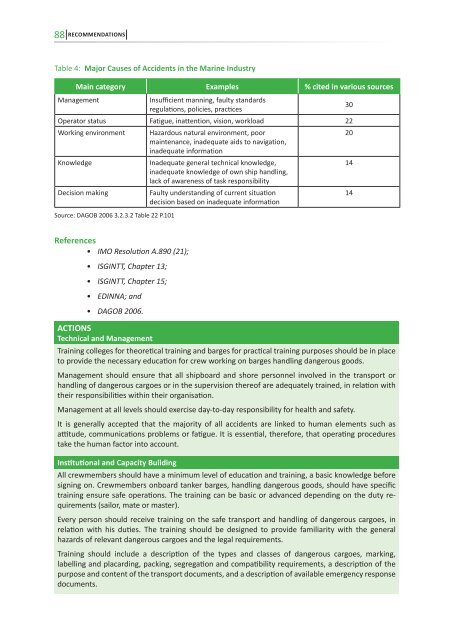Carriage, Handling and Storage of Dangerous Goods along
Carriage, Handling and Storage of Dangerous Goods along
Carriage, Handling and Storage of Dangerous Goods along
You also want an ePaper? Increase the reach of your titles
YUMPU automatically turns print PDFs into web optimized ePapers that Google loves.
88 RECOMMENDATIONS<br />
Table 4: Major Causes <strong>of</strong> Accidents in the Marine Industry<br />
Main category Examples % cited in various sources<br />
Management Insufficient manning, faulty st<strong>and</strong>ards<br />
regulations, policies, practices<br />
Operator status Fatigue, inattention, vision, workload 22<br />
Working environment Hazardous natural environment, poor<br />
maintenance, inadequate aids to navigation,<br />
inadequate information<br />
Knowledge Inadequate general technical knowledge,<br />
inadequate knowledge <strong>of</strong> own ship h<strong>and</strong>ling,<br />
lack <strong>of</strong> awareness <strong>of</strong> task responsibility<br />
Decision making Faulty underst<strong>and</strong>ing <strong>of</strong> current situation<br />
decision based on inadequate information<br />
Source: DAGOB 2006 3.2.3.2 Table 22 P.101<br />
References<br />
• IMO Resolution A.890 (21);<br />
• ISGINTT, Chapter 13;<br />
• ISGINTT, Chapter 15;<br />
• EDINNA; <strong>and</strong><br />
• DAGOB 2006.<br />
ACTIONS<br />
Technical <strong>and</strong> Management<br />
Training colleges for theoretical training <strong>and</strong> barges for practical training purposes should be in place<br />
to provide the necessary education for crew working on barges h<strong>and</strong>ling dangerous goods.<br />
Management should ensure that all shipboard <strong>and</strong> shore personnel involved in the transport or<br />
h<strong>and</strong>ling <strong>of</strong> dangerous cargoes or in the supervision there<strong>of</strong> are adequately trained, in relation with<br />
their responsibilities within their organisation.<br />
Management at all levels should exercise day-to-day responsibility for health <strong>and</strong> safety.<br />
It is generally accepted that the majority <strong>of</strong> all accidents are linked to human elements such as<br />
attitude, communications problems or fatigue. It is essential, therefore, that operating procedures<br />
take the human factor into account.<br />
Institutional <strong>and</strong> Capacity Building<br />
All crewmembers should have a minimum level <strong>of</strong> education <strong>and</strong> training, a basic knowledge before<br />
signing on. Crewmembers onboard tanker barges, h<strong>and</strong>ling dangerous goods, should have specific<br />
training ensure safe operations. The training can be basic or advanced depending on the duty requirements<br />
(sailor, mate or master).<br />
Every person should receive training on the safe transport <strong>and</strong> h<strong>and</strong>ling <strong>of</strong> dangerous cargoes, in<br />
relation with his duties. The training should be designed to provide familiarity with the general<br />
hazards <strong>of</strong> relevant dangerous cargoes <strong>and</strong> the legal requirements.<br />
Training should include a description <strong>of</strong> the types <strong>and</strong> classes <strong>of</strong> dangerous cargoes, marking,<br />
labelling <strong>and</strong> placarding, packing, segregation <strong>and</strong> compatibility requirements, a description <strong>of</strong> the<br />
purpose <strong>and</strong> content <strong>of</strong> the transport documents, <strong>and</strong> a description <strong>of</strong> available emergency response<br />
documents.<br />
30<br />
20<br />
14<br />
14













